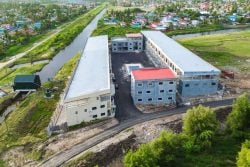Dear Editor,
The groups of people that should be treated with priority are our children and our elderly. Adopting this attitude would contribute tremendously to providing us with a religious, law abiding and progressive country. To compound the damage being done to children by teachers striking to receive satisfactory salary increases, resulting in schools being closed for a prolonged period, other factors are retarding learning and educational excellence.
Present day school designs are unbearable, creating discomfort and discontent among teachers and students. This is due to the prevention of wind entering the buildings and the inability to even look outside. This is not far removed from the design of prisons. The top schools of Queen’s College and Bishops have retained their architectural design and this allows air to easily circulate throughout these buildings. Schools that are being built and reconstructed leave no doubt that pupils and teachers are being treated inhumanely. The windows or attempts at ventilation are inadequate and inefficient. It isn’t simply ventilation but about the ability of the occupants to feel a sufficient amount of wind. The only recourse at these schools is to install air conditioning and that is an avoidable and expensive undertaking. With teachers unable to obtain satisfactory wages, such an investment in schools is unlikely to be considered.
Burkina Faso offers a model of sustainable building solutions to stymie climate change and contributes to preserving the future of humankind. An example relevant to Guyana’s schools is the Lycee Schorge Secondary School. A combination of new material and traditional techniques was utilised. Nine modules were systematically set around a central courtyard, shielding the central area from dust and wind. To build each module, locally obtained laterite was cut into bricks and left in the sun to harden. These bricks would absorb the heat during the day and release it at night. Local eucalyptus wood encircles the classrooms like transparent material and creates shaded areas for students to be safe from the overwhelming daytime heat. The school was designed by the Burkinabe founded architecture firm Kere Architecture, based in Berlin, and shows how countries in the African continent are using traditional building techniques to reduce the carbon footprint of their buildings.
Research shows that these techniques eliminate the need for air conditioning, long distance transportation of materials and concrete production, all of which emit greenhouse gas and accelerate the climate catastrophe. With Guyana’s government’s current focus on infrastructure, it is expected that there will be an exponential increase in construction over the coming years. Guyana is blessed with a diversity of wood and it is likely that we would have one similar to Burkina Faso’s eucalyptus. Locally adapted construction, sustainable design, construction methods and innovation, are necessary to ameliorate the devastating effects of climate change.
The United Nations Environmen-tal Programme (UNEP) combined with the United Nations (UN) Office for Project Services and United Habitat in the Burkina Faso project. Solutions were highlighted in UNEP’s 2022 Global Status Report for Buildings and Construction and set into motion at the UN Climate Conference (COP 27) in Egypt. Inspiration for climate-resilient building is found throughout African history. Many schools in Africa utilize the same techniques adopted by the Lycee Schorge Secondary School. These techniques are even more important in the overcrowded city of Georgetown with most of the population living along the coast.
Sincerely,
Conrad Barrow




